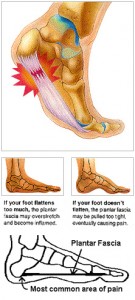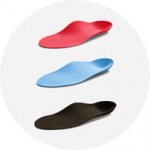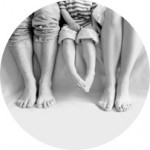Heel Pain (Plantar Fasciitis) – Causes, Symptoms & Treatment
 Heel pain is probably the most common foot complaint. One source indicates that 2 million cases are reported in the U. S. each year. Foot specialists report that 2% to 10% of their patients have it for more than a year.
Heel pain is probably the most common foot complaint. One source indicates that 2 million cases are reported in the U. S. each year. Foot specialists report that 2% to 10% of their patients have it for more than a year.
Heel pain can be mild or debilitating and it can last a few months or a lifetime. It can often appear to be cured, only to return in a few weeks or months.
When heel pain is severe, it is believed to be the result of bone and/or nerve irritation that is the result of too much tension, inflammation, or scar tissue in the fascia. Distinguishing between any number of conditions may not be easy and may be a judgment call on the part of the Chiropodist. You may have a combination. The conditions are often not separate entities.
It is important to have a Chiropodist complete a thorough examination, to determine the cause of the heel pain and the appropriate treatment.
Possible Causes of Heel Pain
- Stress Fracture – bone damage, which may cause pain similar to that produced by Plantar Fasciitis
- Tarsal Tunnel Syndrome – a burning and/or tingling sensation on the bottom of the foot
- Arthritis – inflammation of the joints
- Achilles Tendonitis – pain and swelling are generally localized to the Achilles tendon
- Heel Spurs – a bony growth at the bottom of the heel near the insertion of the plantar fascia. The symptoms can be just like Plantar Fasciitis. Heels are usually painful due to an inflammation of the Plantar Fascia and not due to a sharp stabbing that most people would associate with the work spur. Most people who have heel spurs experience pain due to associated Plantar Fasciitis.
- Plantar Fasciitis – an inflammation of the ligament that runs from the heel to the ball of your foot and helps support your arch. The most prevalent cause of heel pain is Plantar Fasciitis, with over 95% of all heel pain cases. The plantar fascia is a thick fibrous material on the bottom of the foot. It is attached to the heel bone (calcaneus) and fans forward towards the toes. It is responsible for maintaining the arch of the foot.
The problem usually occurs with repetitive stress on the insertion of the plantar fascia. This leads to inflammation at the heel bone and thus, the pain. As the fascia is pulled away from the bone, the body reacts by filling in the space with new bone. This causes the “heel spur”. This heel spur is usually not the problem, but the result of the problem.
The pain feels like a stone bruise and you often can’t sleep it off. Usually the pain is worse in the morning when you get out of bed and after resting, when you stand up. The pain may decrease when you walk a few steps but may never completely go away.
Since it is difficult to rest the foot, a vicious cycle is set up with the situation aggravated with every step. In severe cases, the heel is visibly swollen. The problem progresses rapidly and is much easier to treat when it has just begun, and is not a chronic problem.
There is not one cause of plantar fasciitis. It is usually the results of a combination of risk factors that are present. For example, no everyone with flat feet will injure their plantar fascia, but they will be at a higher risk of injury, especially if another risk factor is present, such as overuse or increasing age.
Possible Causes of Plantar Fasciitis
- Flat pronated feet
- High arched rigid feet
- Overuse
- Inappropriate, or worn out shoes
- Soft terrain (running on sand)
- Inflexibility of Achilles tendon
- Increasing age
- Obesity
In considering risk factors, it is important to remember that a single risk factor usually does not lead to injury.
Treatment for Heel Pain
There are two types of treatment. Firstly, immediate relief of the presenting pain is addressed. Ice, laser therapy and/or strapping may be recommended. The most important type of treatment will be the one that addresses the cause of the problem and therefore prevents re-injury. Orthotics and improved footwear are the most successful forms of treatments.
1) Ice
Icing your foot for 15 minutes several times a day will reduce the inflammation. You should also ice your heel for 15 minutes after activity. Always protect your skin with a paper/tea towel to prevent frostbite.
2) Strapping
The Chiropodist may strap your foot to maintain the arch and relieve some of the plantar fascial tension. This may provide some temporary relief of the discomfort, but will not resolve the problem.
3) Laser Therapy
Cold laser may be applied (like ultrasound) to encourage healing of the injured area. Again, laser therapy alone does not prevent the pain from returning.
4) Orthotics
Custom made orthotics can take the stress off the plantar fascia insertion and should be worn on a daily basis, because the orthotic puts your foot in an improved position, chances of re-injuring the plantar fascia muscle is reduced.
5) Improved Footwear
It is possible for shoes to cause the problem. You may need different or new shoes. A shoe with additional support may be required. It is important to seek advice from your Chiropodist.
6) Surgery
Surgery is rarely required for plantar fasciitis. However, in extreme cases it may be suggested and should be carefully considered.
Since heel pain and plantar fasciitis is a very complicated problem. A thorough evaluation by a Chiropodist is necessary to determine the underlying factors causing the pain. This type of problem often requires a combination of treatments and there is no cure-all solution.
It is important to seek treatment from a licensed foot specialist if you are experiencing heel pain and plantar fasciitis. A chiropodist will identify the cause of your pain and advise you on the best treatment options.
Visit the Foot and Health Clinic and have our Registered Chiropodist assess your feet. We’re located at 728 Burloak Dr. Burlington, just outside of Oakville. Book an appointment online or call us at 905-632-1414.




